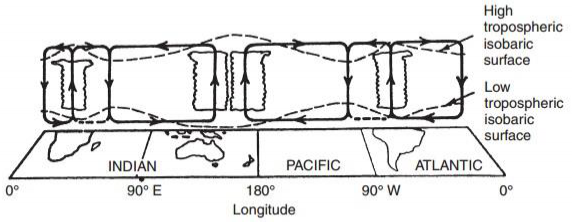1.3. Walker Circulation
The Walker Circulation refers to an east-west circulation of the atmosphere above the tropical Pacific, with air rising above warmer ocean regions (normally in the west), and descending over the cooler ocean areas (normally in the east). Its strength fluctuates with that of the Southern Oscillation. The characteristics of the Walker Circulation were largely determined by the coupling between the tropical atmosphere and oceans. Walker Circulation is closely tied to that of the Southern Oscillation and El Niño. The term Walker Circulation was first introduced in 1969 by Jacob Bjerknes. After Bjerknes, there have been reports of similar east–west circulation cells spanning different longitudinal sectors along the Equator. Compared to pacific cell, these cells cover smaller longitude ranges and tend to have weaker vertical motions (figure 5). The Indian Ocean cell is associated with the development of the South Asian monsoon. Generally, walker circulation is associated with only cells of Pacific Ocean.

